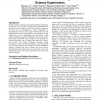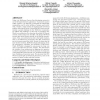HPDC
2010
IEEE
14 years 5 months ago
2010
IEEE
Text analysis tools are nowadays required to process increasingly large corpora which are often organized as small files (abstracts, news articles, etc). Cloud computing offers a ...
HPDC
2010
IEEE
14 years 5 months ago
2010
IEEE
Scientists working in eScience environments often use workflows to carry out their computations. Since the workflows evolve as the research itself evolves, these workflows can be ...
HPDC
2010
IEEE
14 years 5 months ago
2010
IEEE
Hadoop is a reference software framework supporting the Map/Reduce programming model. It relies on the Hadoop Distributed File System (HDFS) as its primary storage system. Althoug...
HPDC
2010
IEEE
14 years 5 months ago
2010
IEEE
The recent emergence of clouds is making the vision of utility computing realizable, i.e. computing resources and services can be delivered, utilized, and paid for as utilities su...
HPDC
2010
IEEE
14 years 5 months ago
2010
IEEE
Cloud computing has emerged as a new approach to large scale computing and is attracting a lot of attention from the scientific and research computing communities. Despite its gro...
HPDC
2010
IEEE
14 years 5 months ago
2010
IEEE
Modern scientific experiments can generate hundreds of gigabytes to terabytes or even petabytes of data that may furthermore be maintained in large numbers of relatively small fil...
HPDC
2010
IEEE
14 years 5 months ago
2010
IEEE
Advances in internetworking technology and the decreasing cost-performance ratio of commodity computing components have enabled Volunteer Computing (VC). VC platforms aggregate te...
HPDC
2010
IEEE
14 years 5 months ago
2010
IEEE
Today, the BitTorrent Peer-to-Peer file-sharing network is one of the largest Internet applications--it generates massive traffic volumes, it is deployed in thousands of independe...
HPDC
2010
IEEE
14 years 5 months ago
2010
IEEE
A significant open issue in cloud computing is performance. Few, if any, cloud providers or technologies offer quantitative performance guarantees. Regardless of the potential adv...
HPDC
2010
IEEE
14 years 5 months ago
2010
IEEE
Voluntary Computing systems or Desktop Grids (DGs) enable sharing of commodity computing resources across the globe and have gained tremendous popularity among scientific research...


